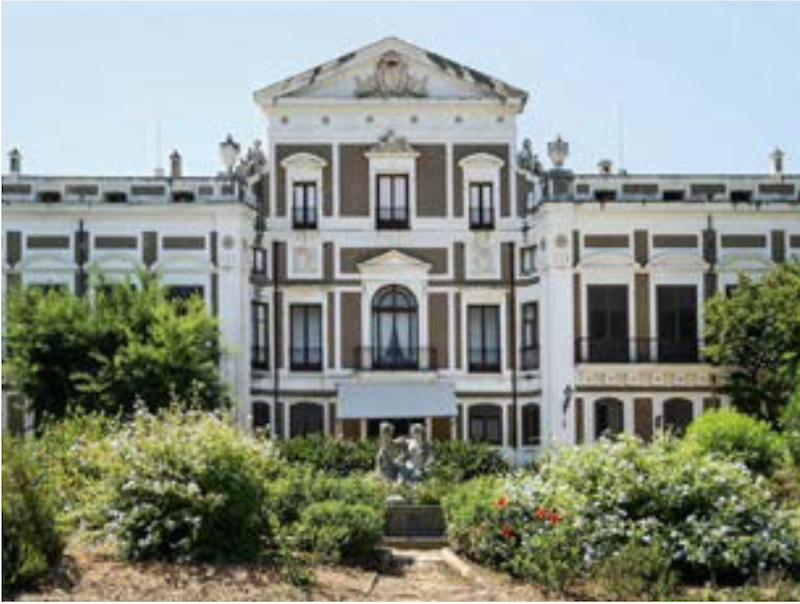
03/ VILLA TRABIA, BAGHERIA
La villa fu edificata verso la metà del 1700 per volontà di Michele Gravina Principe di Comitini e poco dopo venne acquistata dai Lanza Principi di Trabia che diedero seguito al progetto in stile neoclassico iniziato da Nicolò Palma, che la resero unica rispetto alla maggior parte delle ville bagheresi.
The villa was built around the middle of the XVIII Century by the will of the Prince of Comitini, Michele Gravina, and shortly after it was purchased by the Lanza Princes of Trabia who decided to keep the neoclassical style project initiated by Nicolò Palma. This decision made the villa really unique in comparison to the most villas of Bagheria.

La Stanza dell’Irrequieto
Moncada compie uno dei suoi interventi più suggestivi per villa Trabia a Bagheria, la Stanza dell’irrequieto, ambiente interamente pensato come luogo fondato sul dinamismo e sull’energia dei suoi motivi pittorici, tradotti nella ceramica che respira della luce e della libertà di un mondo di confine.
The Room of the Restless
Moncada accomplishes one of his most evocative interventions for the Villa Trabia in Bagheria, the Room of the Restless, an environment entirely conceived as a place founded on the dynamism and energy of his pictorial motifs, translated into the ceramic that inhales the light and the freedom of the border world.

Testo di Sergio Troisi
A partire dall’inizio degli anni Settanta la ceramica ha accompagnato costantemente l’opera pittorica di Ignazio Moncada, recependone modi e segni e declinandoli nella specificità di materie e processi – ma anche forme e strutture quali piatti o vasi – a loro volta carichi di memoria storica.
Realizzata nel 1995 per Villa Trabia, a Bagheria, la Stanza dell’Irrequieto rielabora ugualmente un altro aspetto centrale nella ricerca dell’artista, quella componente della pittura a farsi ambiente e spazio che aveva trovato, nei grandi teloni che rivestivano i ponteggi durante i restauri delle architetture (Pont Art, vennero subito battezzati questi interventi tra il 1982 e il 1992), l’occasione spettacolare per fondere il movimento del colore con quello delle città. Ma già la Pont Art, a sua volta, sviluppava il principio di una vibrazione del colore che nei cicli delle Trasparenze e soprattutto di Alesa variava in termini quasi musicali le strutture segniche e cromatiche.
Nella Stanza dell’Irrequieto quel procedimento teso verso l’esterno si introflette, ed è precisamente questo contrasto tra il movimento di espansione ricercato dalla pittura e l’ambiente interno in cui è articolato a giustificare il richiamo alla irrequietudine. Lungo il rivestimento in ceramica delle pareti, del pavimento e del soffitto della stanza si succedono così quelle articolazioni aperte che negli anni Novanta Moncada aveva sperimentato nei cicli chiamati Ambivalenze e Differenze: impronte lievi di colore come danzanti per trasparenze e sovrapposizioni, con tracce residuali di geometrie elementari – circoli, ellissi – e altre tracce invece in diagonale quasi mosse dalla brezza. Rossi, neri, verdi, turchesi, una tavolozza mediterranea: l’irrequietudine al fondo non è altro che un invito al viaggio.
Text by Sergio Troisi
From the beginning of the seventies ceramics constantly accompanied Ignazio Moncada’s painting work, absorbing its modes and signs and inflecting them in the specificity of materials and processes – but also forms and structures such as plates and vases – which in turn were charged with historical memory.
Created in 1995 for Villa Trabia, in Bagheria, the Room of the Restless similarly reworks another central aspect of the artist’s research, that component of painting which becomes environment and space that he had found in the great tarpaulins covering scaffoldings (ponteggi) during architectural restoration (Pont Art, as these 1982-92 interventions were immediately christened), a spectacular occasion for fusing the movement of colour with that of the city. But Pont Art, in turn, was already developing the principle of a vibration of colour which, in the cycles Transparencies and above all Alesa, varied the signic and chromatic structures in almost musical terms.
In the Room of the Restless that outward-drawn procedure introflexes, and it is precisely this contrast between the movement of expansion sought in painting and the interior environment in which it is articulated that bears out the reference to restlessness. Along the ceramic facing of the walls, floor and ceiling of the room these open articulations succeed one another like this, which Moncada had experimented with in the nineties cycles called Ambivalences and Differences: slight spoors of colour as if dancing in their transparencies and overlaps, with residual traces of elementary geometries – circles, ellipses – and other traces instead in the diagonal, almost as if shifting in the breeze. Reds, blacks, greens, turquoise blues, a Mediterranean palette: restlessness at bottom is none other than an invitation to the journey.


